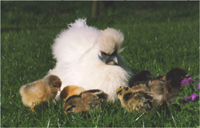Natural Hatching Natural hatching under a broody hen is the ideal way to raise a few chicks and children love the experience. It is, however, essentially dependent on having a broody or broodies at the same time as the eggs you want to set. Silkie crosses make the best broodies; either x Wyandotte or x Sussex but most bantams will go broody. A small pen of these can be bred alongside the purebreds or layers. Successful hatching is achieved with attention to detail and keeping it simple. Nowadays, the bank of wooden sitting boxes has mostly given way to the disposable cardboard carton for hygiene reasons, but make sure it is in a foxproof area, in a quiet spot away from other stock. The individual broody boxes should be large enough for the species and lined with short straw or woodshavings (hay produces harmful moulds), dusted with a pyrethrum based insecticide, plus have good ventilation near the top.
Broody birds of any species which sit beside each other spend their whole time stealing each other’s eggs and generally ruining a hatch. The broody hen is best gently put into a dark cardboard box with straw and slowly taken to the broody box in the dark to keep her sitting and left for a day or so on just a few unimportant or pot eggs to ensure she is still serious and not upset by the move. Some lighter breeds are best left where they decide to sit as if they are moved they will go off being broody. When a hen is broody, a bare patch of skin on her breast (brood patch) is in contact with the eggs to maintain temperature and humidity. Bought-in dayolds should be given a drink by dipping their beaks in tepid water, then place them in a smallish cardboard box so they stay warm and put them within sound of the hen for about an hour. Then take them out, concealing them in your palm and place them gently under her, removing the eggs at the same time. Best done in the dark, but it will depend on what time of day you get the chicks. Remember you have only 24 hours if you wish to add more: she cannot count but she has colour vision and can tell the difference between chicks. |



